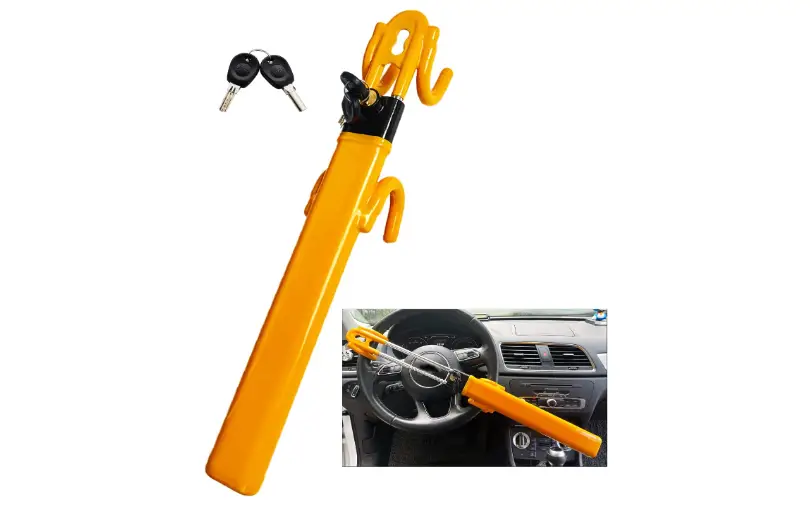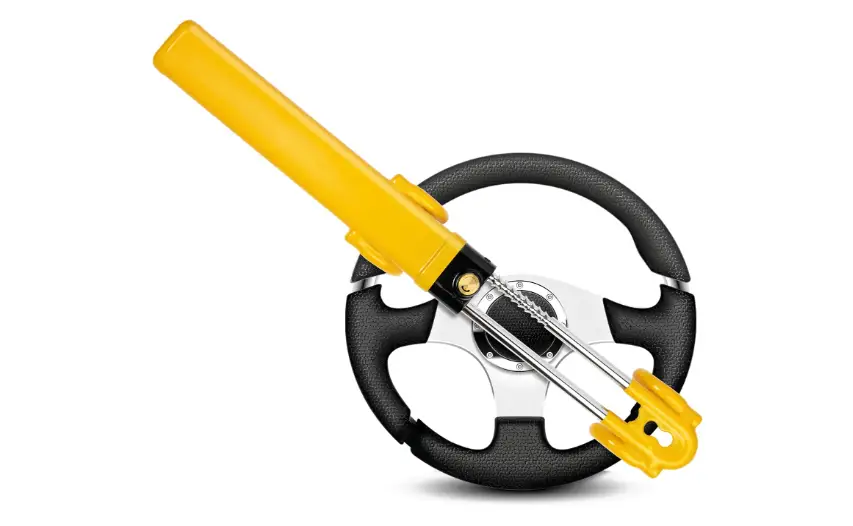A steering wheel lock immobilizes the steering wheel, making it difficult for a thief to drive the vehicle, while a wheel clamp locks around a tire, preventing the car from moving entirely. Both serve as visible deterrents, but the wheel clamp provides a more robust barrier, as it physically stops the vehicle from rolling.
Vehicle theft continues to be a significant concern for car owners globally, despite advancements in car security technologies. As thieves become more sophisticated, car owners are increasingly turning to physical anti-theft devices to protect their vehicles.
Among the most popular options are steering wheel locks and wheel clamps. Both are designed to deter theft by making it difficult for criminals to move the vehicle, but they function in different ways and offer varying levels of protection.
Contents
1. Understanding the Devices
Steering Wheel Lock
A steering wheel lock is a metal device that locks onto the steering wheel, preventing it from being turned. The most common design is a bar that extends across the diameter of the steering wheel, hooking onto its rim. Some models extend further, covering a larger portion of the wheel or even encasing it entirely. The lock is typically operated by a key, though some newer models use combination locks or even biometric systems.
How It Works: The steering wheel lock’s primary function is to restrict the wheel’s movement, making it impossible to steer the car. Even if a thief manages to start the engine, they won’t be able to drive the car away unless they can remove the lock, which would require time, tools, and a certain level of expertise.

Wheel Clamp
A wheel clamp, also known as a tire lock or boot, is a device that immobilizes one of the vehicle’s wheels. It typically consists of two metal arms that grip the tire, with a locking mechanism that secures it in place. The clamp prevents the wheel from rotating, effectively disabling the vehicle. Some wheel clamps also cover the lug nuts, preventing the wheel from being removed and replaced with a spare.
How It Works: Once applied, the wheel clamp prevents the vehicle from moving, regardless of whether the engine is running or the steering wheel is unlocked. It’s a highly visible deterrent that signals to potential thieves that the vehicle is not an easy target. Removing a wheel clamp without the key or a specialized tool is extremely difficult and time-consuming.

2. Effectiveness as a Theft Deterrent
Steering Wheel Lock
Steering wheel locks serve as both a physical barrier and a visual deterrent. The presence of a steering wheel lock can discourage a thief from attempting to steal the vehicle, as it suggests that the owner has taken additional security measures. However, steering wheel locks are not foolproof. Some criminals carry tools that can cut through the lock or manipulate the steering column to bypass it. Despite these potential vulnerabilities, steering wheel locks are generally effective against opportunistic thieves who are looking for an easy target.
Pros:
- Easy to install and remove.
- Acts as a visible deterrent.
- Relatively inexpensive.
- Portable and easy to store.
Cons:
- Can be bypassed by determined thieves with the right tools.
- Provides limited protection against towing.
Wheel Clamp
Wheel clamps are generally considered more secure than steering wheel locks because they physically prevent the vehicle from moving. The clamp makes it difficult, if not impossible, for a thief to drive the car away. Additionally, the presence of a wheel clamp can be a significant deterrent, as it indicates that the vehicle is well-protected. Unlike steering wheel locks, which can sometimes be defeated by tampering with the steering column, wheel clamps require more effort and specialized tools to remove.
Pros:
- Provides a high level of security by immobilizing the vehicle.
- Acts as a strong visual deterrent.
- Difficult to remove without the key or specific tools.
- Some models protect the lug nuts, preventing wheel removal.
Cons:
- Bulkier and less convenient to install and remove compared to steering wheel locks.
- More expensive.
- Harder to store due to its size and weight.
3. Ease of Use
Steering Wheel Lock
One of the key advantages of a steering wheel lock is its ease of use. Most models can be installed or removed in a matter of seconds, making it convenient for daily use. The lock is also compact enough to be stored in the vehicle when not in use, such as under the seat or in the trunk. For those who prioritize convenience, the steering wheel lock is a practical choice.
Ease of Use:
- Quick to install and remove (usually less than 30 seconds).
- Lightweight and easy to store.
- No special skills or tools required for installation.
Wheel Clamp
Wheel clamps, while effective, are generally less convenient to use than steering wheel locks. Installing a wheel clamp involves positioning it correctly around the tire and securing it, which can take a few minutes. The process may also be more challenging in bad weather or low-light conditions. Additionally, wheel clamps are larger and heavier, making them more difficult to store in the vehicle. Despite these challenges, the superior security offered by a wheel clamp may be worth the extra effort for some users.
Ease of Use:
- Takes longer to install and remove (typically a few minutes).
- Bulkier and heavier, making storage more challenging.
- Requires more effort to position and secure.
4. Price and Value
Steering Wheel Lock
Steering wheel locks are generally affordable, with prices ranging from $20 to $100, depending on the brand and features. Basic models offer good protection, while more expensive options may include advanced features like reinforced materials, better locking mechanisms, or alarms. For the price, steering wheel locks offer good value, especially for those looking for an easy-to-use, portable security device.
Price Range:
- Affordable, typically between $20 and $100.
- Higher-end models may include additional features like alarms or better locks.
Wheel Clamp
Wheel clamps are more expensive, with prices ranging from $50 to $200 or more, depending on the size, material, and features. The higher cost reflects the increased level of security they provide. For vehicle owners who prioritize security and are willing to invest in a more robust solution, a wheel clamp offers excellent value. However, the added cost and inconvenience may be a consideration for some users.
Price Range:
- More expensive, typically between $50 and $200.
- Higher-end models may include features like lug nut protection or integrated alarms.
5. Practical Considerations
When to Use a Steering Wheel Lock
A steering wheel lock is ideal for everyday use, particularly for vehicles parked in relatively safe areas. It’s a good option for those who want a quick and convenient way to add an extra layer of security to their vehicle. It’s also a suitable choice for people who frequently move their car, as the lock can be easily installed and removed.
When to Use a Wheel Clamp
A wheel clamp is best suited for situations where the vehicle will be parked for an extended period or in a location with a higher risk of theft. It’s also a good option for securing vehicles that are not frequently driven, such as trailers, boats, or RVs. While the wheel clamp is less convenient to use, the added security it provides makes it a worthwhile investment for protecting high-value vehicles or those stored in vulnerable locations.
6. Conclusion: Which is Better?
The choice between a steering wheel lock and a wheel clamp ultimately depends on your specific needs and circumstances.
- If you prioritize convenience and are looking for a deterrent that you can use daily, a steering wheel lock is the better option. It’s easy to use, affordable, and provides a visible deterrent that can discourage most thieves.
- If security is your primary concern and you are willing to invest in a more robust solution, a wheel clamp is the superior choice. It offers a higher level of protection by physically immobilizing the vehicle and is much harder to bypass.
Conclusion
In some cases, using both devices together can provide the best of both worlds, combining the ease of use of a steering wheel lock with the superior security of a wheel clamp. This layered approach can be particularly effective in high-risk areas or for high-value vehicles, giving you peace of mind that your vehicle is well-protected.
Ultimately, both the steering wheel lock and the wheel clamp serve as valuable tools in your vehicle security arsenal. By understanding their strengths and limitations, you can make an informed decision that best suits your needs and ensures your vehicle remains safe from theft.